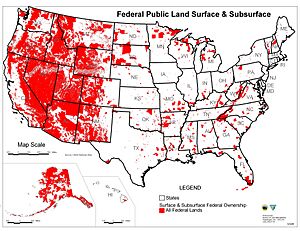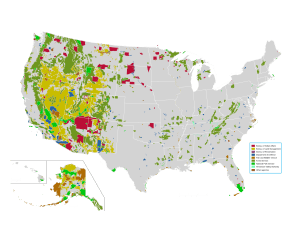Federal lands facts for kids

Federal lands are areas of land in the United States that are owned by the public and managed by the U.S. federal government. The United States Constitution gives Congress the power to keep, buy, sell, and make rules for these lands. For example, Congress can limit how much cattle can graze on federal lands. The United States Supreme Court has always agreed with these powers.
The U.S. government manages about 640 million acres (about 2.6 million square kilometers) of land. This is about 28% of all the land in the United States. Most of these federal lands are in Alaska and the Western states.
Most federal lands (about 95%) are managed by four main groups:
- The Bureau of Land Management (BLM)
- The United States Fish and Wildlife Service (FWS)
- The National Park Service (NPS)
- The United States Forest Service (USFS)
The BLM, FWS, and NPS are part of the United States Department of the Interior. The Forest Service is part of the United States Department of Agriculture. The United States Department of Defense (DOD) also manages about 11.4 million acres (about 46,000 square kilometers) of land, which is about 2% of all federal land.
Contents
What the Law Says About Federal Lands
The U.S. Supreme Court has strongly supported the federal government's wide powers over these lands. For example, in a case called Kleppe v. New Mexico, the Court said that Congress has the full power to manage and protect wildlife on federal lands, even if state laws are different.
Lands held by the U.S. government for Native American tribes are usually not seen as public lands. The government holds about 55 million acres (about 220,000 square kilometers) for tribes and nearly 11 million acres (about 45,000 square kilometers) for individual Native Americans. Even though the U.S. government legally owns these lands, the tribes or individuals have the right to use and benefit from them. This means these lands are "quasi-private," not public. However, because the U.S. government is the legal owner, it must approve any deals or uses of resources on these lands.
How Federal Lands Came to Be
After the American Revolution, the first states gave land to the new federal government. Laws like the Land Ordinance of 1785 and the Northwest Ordinance of 1787 helped survey and settle these lands. As the United States gained more land from countries like Spain and France, Congress made sure these new areas were explored, surveyed, and opened for people to settle.
In the early days, the U.S. government needed money to run the country. So, it sold land. To sell land, it first had to be measured and mapped. This led to the development of a modern public land survey system. In 1812, Congress created the United States General Land Office to manage the sale of these federal lands.
In the 1800s, more laws were passed to give away federal land. These included the Homestead Act of 1862, which allowed people to claim land if they lived on it and improved it. Many different types of land claims existed, like for soldiers, miners, or railroads. This system of local land offices spread across the country. However, giving away land largely stopped after 1935, and the Homestead Act ended in 1986.
Over time, the government's approach changed. Instead of selling off public land, it started keeping and managing it. Laws like the Mineral Leasing Act of 1920 allowed companies to lease public lands to find and produce resources like coal, oil, and gas. The Taylor Grazing Act of 1934 helped manage public grazing lands.
In the 1970s and 1980s, a movement called the Sagebrush Rebellion grew in the Western United States. People in this movement wanted states and local governments to have more control over federal lands, or even for the lands to be sold to private owners.
From 1990 to 2018, the total amount of land held by the federal government actually went down by about 4.9%. This was mainly due to less land being held by the Bureau of Land Management and the Department of Defense.
Who Manages Federal Lands?
The four main groups that manage federal lands are:
- Department of the Interior
- Bureau of Land Management (BLM) - This agency was formed in 1946. It manages about 244.4 million acres (about 989,000 square kilometers) of federal lands, more than any other agency. Most of these lands are in the Western states or Alaska. The BLM focuses on rangelands but also manages lands for recreation, timber, energy, minerals, and conservation.
- United States Fish and Wildlife Service (FWS) - The FWS manages about 89.2 million acres (about 361,000 square kilometers) of federal land. Most of this land (85.9%) is in Alaska. The FWS mainly works to protect and promote wildlife.
- National Park Service (NPS) - The NPS manages about 79.9 million acres (about 323,000 square kilometers) of federal land. About 66% of this is in Alaska. The NPS oversees many different types of places, including national parks, national monuments, and national historic sites.
- Department of Agriculture
- United States Forest Service (USFS) - The USFS manages about 192.9 million acres (about 781,000 square kilometers) of national forests. While most of their lands are in the West, the USFS also manages about 60% of all federal lands in the Eastern United States.
The fifth largest federal landowner is the United States Department of Defense (DOD). The DOD manages about 8.8 million acres (about 35,600 square kilometers) in the United States. These lands are mostly military bases and training areas. The largest single DOD land area is the 2.3-million-acre White Sands Missile Range in New Mexico.
Together, these five groups manage about 96% of all federal land. Other agencies like the United States Army Corps of Engineers and the National Aeronautics and Space Administration (NASA) manage the rest.
Where Are Federal Lands Located?
Federal lands are mostly found in the Western United States. Across the whole country, the federal government owns about 27.4% of all land. This varies a lot by region. For example, the federal government owns 61.3% of the land in Alaska and 46.4% in the 11 Western states. In other states, it owns only about 4.2% of the land. Nevada has the highest percentage of federal land (80.1%), while Connecticut and Iowa have the lowest (0.3%).
Important Laws About Federal Lands
Here are some important laws that guide how federal lands are managed:
- Alaska National Interest Lands Conservation Act
- Endangered Species Act
- Federal Land Policy and Management Act of 1976 (FLPMA)
- Mineral Leasing Act
- National Environmental Policy Act (NEPA)
- Taylor Grazing Act
- Wild and Free-Roaming Horses and Burros Act of 1971
Acquired Lands
Acquired lands are a special type of public land. These are lands that the federal government got by buying them, taking them for public use (called condemnation), receiving them as a gift, or trading for them.
Uses of Federal Lands
Federal lands are often used for environmental conservation, which means protecting nature. For example, in 2023 alone, the U.S. government turned 12.5 million acres (about 50,600 square kilometers) into protected areas.
See also
- Public lands in the United States
- Federal enclave


